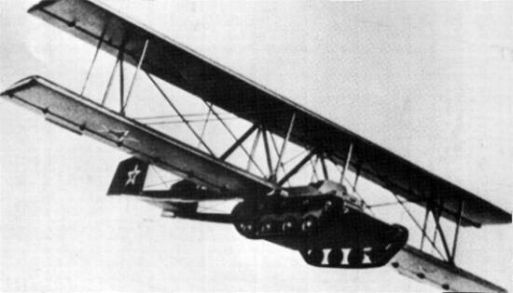- Antonov A-40
infobox Aircraft
name = A-40 Krylya Tanka
type = Glider
manufacturer =Antonov 
caption = Designer's model of the Antonov A-40
designer =Oleg Antonov
first flight = 1942
introduced =
retired =
produced =
number built = 1
status = Cancelled
unit cost =
primary user =Soviet Air Force
more users =
developed from = T-60 tank
variants with their own articles = The Antonov A-40 "Krylya Tanka" (Russian: "tank wings") was a Soviet attempt to allow atank to glide into a battlefield after being towed aloft by an airplane, to support airborne forces or partisans. A prototype was built and tested in 1942, but was found to be unworkable. This vehicle is sometimes called the "A-40T" or "KT".Design and development
Instead of loading
light tank s onto gliders, as other nations had done, Sovietairborne forces had strappedT-27 tankette s underneath heavy bombers and landed them on airfields. In the 1930s there were experimental efforts toparachute tanks or simply drop them into water. During the 1940 occupation of Bessarabia, light tanks may have been dropped from a few metres byTB-3 bombers, allowing them to roll to a stop with theclutch in neutral.The biggest problem with air-dropping vehicles is that their crews drop separately, and may be delayed or prevented from bringing them into action. Gliders allow crews to arrive at the drop zone along with their vehicles. They also minimize exposure of the valuable towing aircraft, which needn't appear over the battlefield. So the
Soviet Air Force orderedOleg Antonov to design a glider for landing tanks.Antonov was more ambitious, and instead of building a glider added a detachable cradle to a
T-60 light tank, bearing large wood and fabricbiplane wings andtwin tail . Such a tank could glide into the battlefield, drop its wings, and be ready to fight within minutes.One T-60 was converted into a glider in 1942, intended to be towed by a
Petlyakov Pe-8 orTupolev TB-3 . The tank was lightened for air use by removing armament, ammunition, headlights and leaving a very limited amount of fuel. Even with the modifications, the TB-3 bomber had to ditch the glider during its only flight onSeptember 2 ,1942 to avoid crashing, due to the T-60's extreme drag (although the tank reportedly glided smoothly). A-40 was piloted by the famous Soviet glider experimental pilotSergey Anokhin . The T-60 landed on a field near the airdrome, and after dropping the glider wings and tail, the driver returned it to its base. Due to the lack of sufficiently-powerful aircraft to tow it at the required 160 km/h, the project was abandoned.The Soviet Union continued to develop methods to efficiently deploy airborne vehicles. By the mid-1970s they were able to para-drop BMD-1 fighting vehicles with crew members aboard.
Specifications
See also
*
Winged tank
*Baynes Bat , a British design of WW2 to add glider wings to a tank
*General Aircraft Hamilcar , a military glider of the period capable of carrying light tanks.
*Messerschmitt Me 321 andJunkers Ju 322 , German gliders designed to be capable of carrying light armored vehicles.
* TheT-80 andT-84 have also been nicknamed "Flying Tank" for their speedNotes
References
*
*
*External links
* [http://www.battlefield.ru/index.php?option=com_content&task=view&id=98&Itemid=50&lang=en T-60 modifications] at battlefield.ru
* [http://www.unrealaircraft.com/roadable/antonov_kt.php Antonov KT flying tank] at unrealaircraft.com
* [http://aeroweb.lucia.it/~agretch/RAFAQ/KT-40.html KT-40 flying tank] at the Russian Aviation Page
* [http://www.lizdas.lt/aviacija/ivairenybes/flying_tank.htm Krylja Tanka] , illustrated page in Lithuanian
* [http://blog.modernmechanix.com/2006/07/10/flying-tanks-that-shed-their-wings "Flying Tanks that Shed Their Wings"] by Lew Holt in "Modern Mechanics and Inventions", July 1932.
Wikimedia Foundation. 2010.
